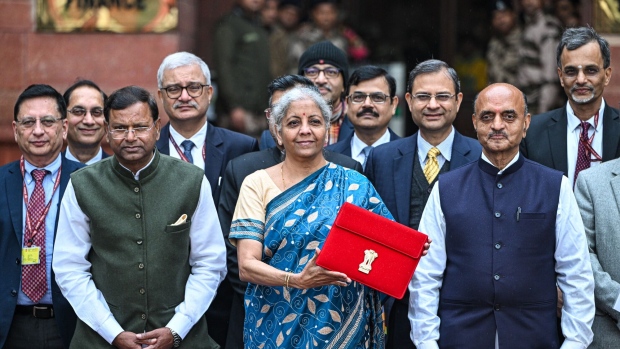Feb 1, 2024
Who Gained and Who Lost in Modi’s Last Budget Before Polls
, Bloomberg News

(Bloomberg) -- The last budget of Prime Minister Narendra Modi’s administration before national polls tried to strike a chord with key voting blocs such as farmers and the poor, while sticking to fiscal prudence.
Finance Minister Nirmala Sitharaman announced measures to boost tourism, housing and renewable energy adoption in her interim budget Thursday, but the proposed spending on roads, ports and airports in the wold’s fastest-growing major economy fell short of expectations. Bonds rallied on her plan to lower market borrowings, while stocks were lower.
“The next five years will be years of unprecedented development and golden moments to realize the dream of developed India by 2047,” she said.
A full budget will be presented by the new government after election in April and May. Modi is in a strong position to extend his decade in power as his popularity is growing after winning some recent state elections and the opening of a controversial Hindu temple.
“The interim budget is short of any big bang announcements, but the policy prerogatives and spirit has not been derailed,” said Madhavi Arora, lead economist with Emkay Global Financial Services. “There have been few relief and focused measures” for the rural and farm sector.
Here’s a look at some of the winners and losers of the interim budget:
WINNERS
Agriculture
India is planning to promote private and public investments in post-harvest activities, including modern storage and supply chains, in addition to boosting self reliance on oilseeds. It is planning a comprehensive program for the development of dairy farmers and would also step up spending on fisheries to boost productivity of the sector.
Read More: India Milk Stocks Rise on Government Plan for Dairy Development
Middle Class
The government will launch a program to help some sections of the middle class living in rented houses, slums and unauthorized colonies to buy or build their own houses. The financial aid is a welcome move as ‘housing for all’ is a significant marker of economic progress and a developed country, said Neeraj Bansal, co-head and chief operating officer, India Global, KPMG.
Tourism
The government will encourage states to develop tourist centers and market them at global scale. It is also planning long-term interest-free loan to states for tourism.
Read More: Tourism Stocks Rise as India Plans Measures to Boost Sector
Renewable Energy
While the government announced viability gap funding for harnessing wind energy potential for initial capacity of 1 gigawatt, it fell short of expectations. The industry was looking for a subsidy program to incentivize the adoption of renewable energy considering India plans to become net carbon zero by 2070. The industry expected more details on how the programs would be funded.
LOSERS
Infrastructure
The budget laid out a modest increase of 11.1% in infrastructure outlay, taking the proposed spend to 11.1 trillion rupees in the next financial year. To address the challenges of “deteriorating infrastructure, India must consider a more substantial increase in investment”, said Pradeep Gupta, vice chairman of Anand Rathi Group.
Read More: India Infra Stocks Fall as FY25 Capex Spending Growth Slows
Electric Vehicles
The government is planning to “expand and strengthen electric vehicle ecosystem” through measures including developing public charging infra and wider adoption of electric public transport. However, it didn’t extend the $1.2 billion subsidy program that’s ending in March.
Jewelers
Jewelry stocks, including Tata Group’s Titan Co., Kalyan Jewellers India Ltd. and Senco Gold, fell Thursday as the government left the import tax on gold unchanged at a high level of 15%. The industry has repeatedly sought a reduction in the tax to stem illegal inflows into the country and aid demand as a lower duty would make the precious metal cheaper for consumers. India imports almost all the gold it consumes.
Disinvestment
India slashed its disinvestment target for the current fiscal year after failing to conclude some high-ticket stake sales. It is expecting to get 300 billion rupees from disinvestment in the year through March 2024, revised down from earlier target of 510 billion rupees. The goal for the next year has been set at 500 billion rupees.
Read More: India Sees Lower Dividend Income from State Firms, Banks
--With assistance from Alex Gabriel Simon, Satviki Sanjay, Swansy Afonso and Lou Del Bello.
(Adds economist comment in fifth paragraph. A previous version of the story was corrected to remove a reference to tax rates.)
©2024 Bloomberg L.P.


